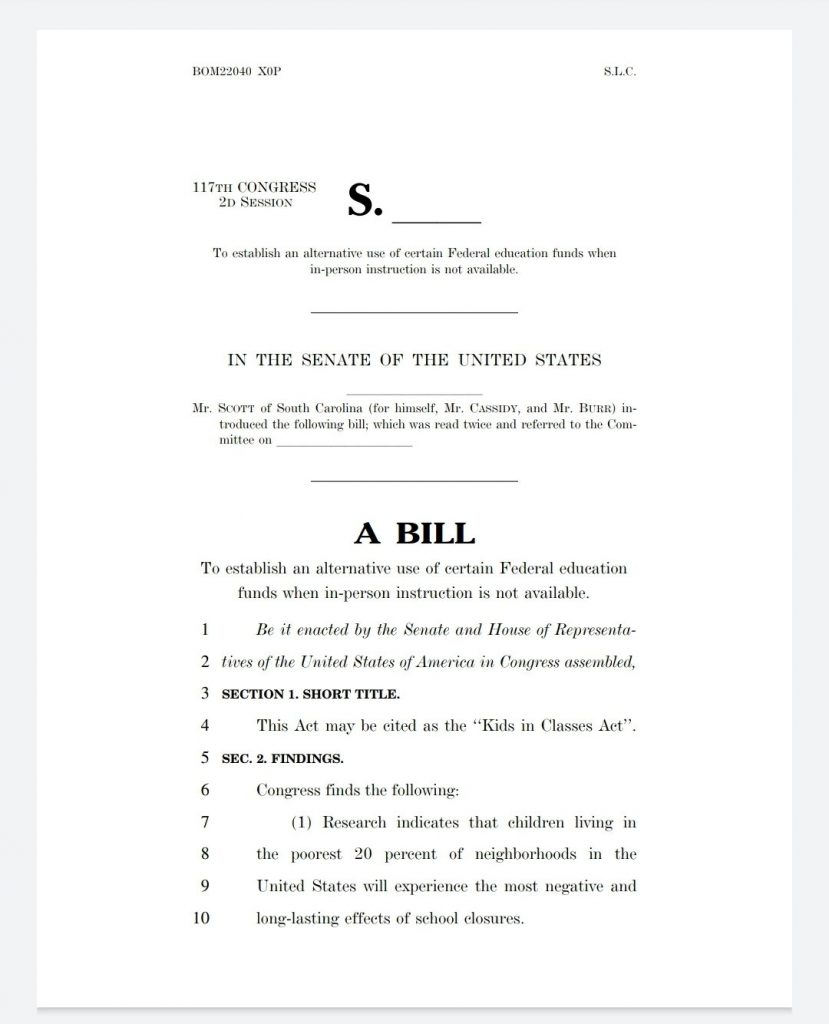Read The Kids In Classes Act Introduced In US Senate, Closed Schools Giving Parents Money Back
The battle to keep kids in class moves on. Legislators are pulling out all the stops in getting children back into the classroom. The new Kids in Classes Act is one bill that will surely help.

The battle to keep kids in class moves on. Legislators are pulling out all the stops in getting children back into the classroom. The new Kids in Classes Act is one bill that will surely help.
Introduced by U.S. Senators Bill Cassidy, M.D. (R-LA), Tim Scott (R-SC), and Richard Burr (R-NC), the Kids in Classes Act goes right at the problem. It would allow for families with children who attend Title I schools to grab their unused federal education funds and put them to use toward in-person education. These funds could be used if their schools close down due to COVID and its many variants or if there is a teachers union strike.
“When teachers’ unions have more say in a child’s education than that child’s own parent, we have a problem,” said Dr. Cassidy on his website. “The science is clear, kids need to be in the classroom. Our bill empowers parents to choose what is best for their child’s education.”
Here’s a look at the first page of the Kids in Classes bill. Read for yourself…

Yes, the science is clear when it comes to the damage seen by the lengthy school shutdowns from the COVID pandemic. It has been seen over the “two weeks to slow the spread” nonsense to what is now entering the third year of the pandemic, that the damage has been done and it is looking like the lost time is time students will not be getting back. All the while, schools and their districts continue to receive the funds.
The Kids in Classes Act aims to rectify these wrongs. Senator Scott acknowledges what many parents already know – the schools’ closures have failed children across the nation. Particularly, as Scott points out, “students in marginalized communities whose families are living paycheck-to-paycheck.” He continued, “As districts continue to bow to the demands of labor unions, we must ensure our nation’s children are protected from further learning loss and isolation. Enabling all kids to achieve the American Dream starts with giving all kids the education they deserve—no matter their zip code.”
The data is out as it concerns students who live in the poorest United States neighborhoods. School closures will cause the most negative and longest-lasting effects on children in these neighborhoods. With the passage of the Kids in Classes Act, it will allow families in these challenging areas to take their unused Title I funds and put them to use towards private school tuitions, fees for testing, curricular materials, tutoring, books, instructional and technological educational materials, and the funds could also be used for educational therapies for students with disabilities.
“Students are more successful when they are in the classroom, parents know that and data proves it,” said Senator Burr. “This legislation will help keep children in the classroom by giving families the option to continue using Title I funds at a different, in-person school should their child’s current public school close because of COVID-19. I’m proud to work with Senators Scott and Cassidy on this important legislation to help families avoid the devastating impacts of unnecessary school closures.”
This is just one of the more recent bills to be introduced to the legislature with the goal of keeping kids in classes or returning them to class. On January 18, 2022, Congresswoman Kat Cammack (R-FL-03) introduced the Keep Kids in Schools Act of 2022, which was the House companion to Senator Marco Rubio’s (R-FL) bill he introduced on January 10, 2022. The bill would stop nearly $164 million in unspent COVID relief funds from going to elementary and secondary schools that are not offering to students in-person learning on a full-time basis.
With parents and legislators on the same side, there has been plenty of positive movement in getting kids back into school on a full-time basis. The hope here is that they can somehow make up for the lost time. Getting teacher’s unions to go along might take a little more time, unfortunately.







